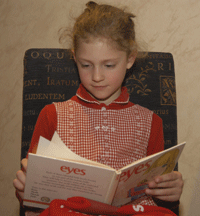As the summer holidays begin, more children tend to trickle in through the practice doors. Suzanne Floyd gives some advice
While an eye examination can be a daunting experience for some children, it can also be a worrying time for the optometrist should the inquisitive fingers of a 'difficult' child start to explore expensive consulting room equipment. It is important to be confident of keeping children 'on track' during not only the examination but also in the longer term with spectacle wear, amblyopia therapy or vision training.
Children arrive in our consulting room with a visual problem to resolve. 'Difficult' children range from those who, suddenly overcome with shyness, close their eyes or won't raise their head from mum's lap, to those who conduct themselves inappropriately or who have problems arising from medical or behavioural disorders. Whatever the cause, our task is to diagnose, prescribe when necessary, and review. Mutual respect is crucial to keeping examination and treatment on track.
YOUNGER CHILDREN
Allowing the anxious younger child some space and time to look around and settle is helpful before creating a dialogue. Even the elective mute will respond, by expression or gesture, and when the child does choose to talk, listen seriously to what they have to say. Seek permission to proceed, suggesting that they are in control and can stop the examination at any point. Make calm, unhurried approaches, initially from below and from the side, using non-threatening body language.
Try not to respond to negative behaviour, choosing instead to reserve your enthusiasm and praise to support the behaviour you want to achieve. So, while it may be tempting to scream 'don't touch' at the enquiring seven-year-old on a finger-printing mission, it is actually better to enlist support by sharing the responsibility for diagnosis. Engage their attention, explain procedures and express interest and pleasure in their responses.
With the primary goals being to establish visual acuity, cover test results and retinoscopy, it may be necessary to ditch your normal routine.
 |
| A choice of kids' books from your bookshelf will establish an indication of reading level |
Parents' suggestion that their child is a 'good' or 'poor' reader does not always give a very realistic idea of ability. A McClure Near Chart or a choice of children's books from your bookshelf will quickly establish an indication of reading level and aid a decision on whether symptoms may be helped by spectacles, overlays or vision training. Cycloplegic refraction can often be avoided and co-operation gained over two or three trips, if necessary.
However, when the full refraction is required, a young child can be laid back on mum's lap and the eye-drops dripped onto the closed lid margins. The drops will then trickle gently into the eye upon opening. Retinoscopy can also be accomplished on sleeping, or feeding, babies.
An unhurried, unassuming approach should enlist support and make the child a partner-in-effort. Once ability is established, motivation can be maintained by setting tasks at a level to challenge while sustaining confidence. Learning theories suggest that a success rate as high as 75 to 80 per cent can be necessary to maintain self-esteem and interest.
Emotional drivers have been proved stronger than material gain, and pleasure or praise rate as the best reward. Providing immediate feedback encourages the child's co-operation for spectacle wear and follow-up and a support structure, such as falling back to letter-matching or tracing shapes in the air, develops confidence towards the point where children can feel relaxed about 'mistakes'.
LONGER TERM
Sustaining long-term motivation for vision training requires a much greater degree of co-operation between all parties. The problem needs to be clearly identified by the optometrist and understood by the parent and the child. A willingness to make changes should be established and the time, effort and expense involved need contemplation and preparation.
Vision training demands particular skills from the optometrist in terms of delivering enthusiasm and praise aimed to inspire and motivate. The responsibility for planning for a treatment programme, monitoring progress and establishing a support structure is a shared one and requires the combined efforts of optometrist, parent and child. Improvement is achieved through appropriate goal setting and the freedom to make changes without any feeling of blame or punishment for going 'off track'. Systems need to be agreed whereby success can be recognised, recorded and monitored.
It is 'okay to fail'; the important point is to build sufficient confidence to enable the child to get back 'on track' and resume progress. Progress can be evaluated and recorded on charts and the goals re-adjusted and revised appropriately. Goals require a specific aim and must be realistic and achievable within an allotted time. While there should always be an acceptable and achievable long-term target, as with any training program, it is the daily goals that are the single most important factor in improvement.
So, a long-term target might be to improve reading speed, the mid-term target to improve an accommodation-convergence insufficiency, and the daily goal, to walk an imaginary bug slowly down a string towards the nose, three times. It is the repeated achievement of the daily goal that results in improved near point of convergence, allowing sustained near work and an eventual improvement of reading ability.
Initially, full attention will need to be associated with the activity but as ability improves it will become possible to re-direct attention elsewhere, through multi-sensory task loading so that the skills become embedded to second nature reactions. In the case of the accommodation-convergence insufficiency, it should eventually become possible to concentrate, for example, on threading a needle while holding a conversation and without any particular conscious effort directed towards maintaining the near point focus.
Children need to self-discover, self-explore and self-motivate. During our examination and through vision training we can help them to do this. Our interest and enthusiasm makes children feel good about themselves and helps to maintain mutual respect.
